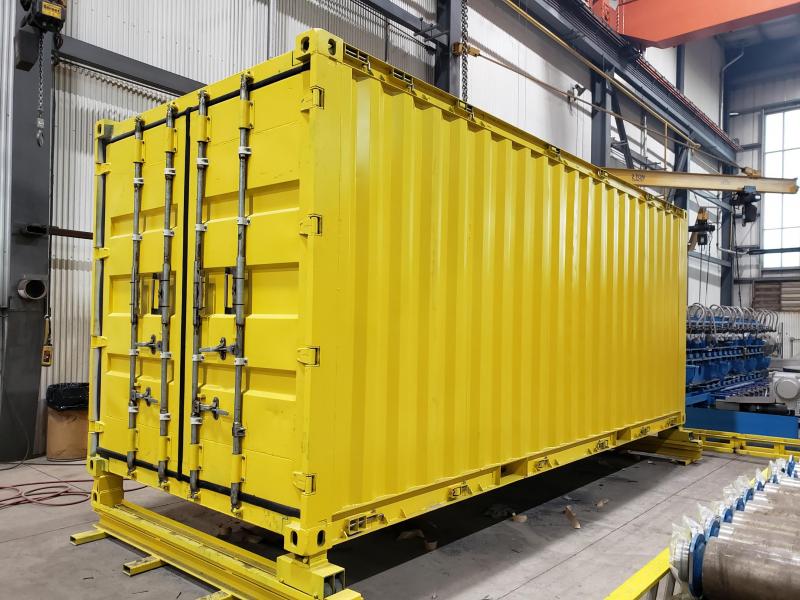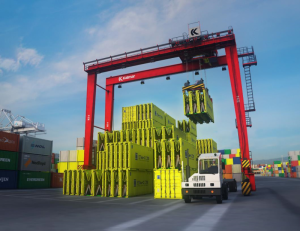A solution to the backlog of shipping containers at the nation’s ports may be in the hands of a few entrepreneurs in Delaware.
Staxxon Folding Containers, a Delaware-incorporated company, offers a revolutionary shipping container design that can be folded vertically once a container is empty. This ultimately saves space at the ports by compacting empty containers for a smaller footprint, instead of stacking full-sized containers as they wait to be hauled away.
Stacks of empty shipping containers taking up a lot of space are exactly what Staxxon founder and engineer George Kochanowski saw a decade ago while driving along the Eastern Seaboard. Kochanowski immediately went to work designing a solution, said Santtu Seppälä, Staxxon chief strategy officer.
Ten years and five partners later, Staxxon is ready to introduce the shipping world to its innovative container.
Seppälä said their patented design is the only one of its kind. Thirty-eight patents that include the U.S., EU, and China are meant to keep it that way.
“One of the reasons why it’s taken us this long is because we wanted to build our intellectual property portfolio to be robust enough so that when we do launch commercially, there isn’t a doubt that we will be able to defend our product and patents in court,” he said.
Shipping containers are also different from other products that can be easily copied, such as those in the technology world.
The key is a certain code stamped on and assigned to each container, similar to a license plate.
“We’re the only company in the world that has a vertically folding container design. So if anybody were to try to mimic our vertically folding container design, they would also have to get that license plate issued,” he said, adding that Staxxon would get royalties in exchange. “We hope to block fraudulent containers from being made and used in the field.”
Staxxon’s unique design allows containers to be folded into a variety of configurations. Bundles can be made from two, three, four, or five containers that can fit into the footprint of one regular container. “You can lift it, move it, stack it just like any other box,” Seppälä said. “All the bundled configuration sets are the same specs as an ISO regular container. It fits into the flow and supply chain perfectly. It’s 100 percent intermixable.”
The container also folds easily. The process takes about 10 minutes for a manual approach, using a forklift and two workers, Seppälä said, and less than 3 minutes for a fully automated process. “It means one station could be doing 450 containers in a 24-hour period,” he said. “It ends up not being a bottleneck in terms of the system. That would be the Achilles heel and would prevent widespread adoption, if you can’t fold and unfold these containers quickly and easily.”
For further efficiency, Seppälä said, folding stations could be built nearby but off port property, helping to further ease the space crunch.
The Staxxon design will also benefit the environment, Seppälä said. The way the shipping industry works now, he said, once a single container is empty, a truck comes and carts it away. This equals one trip per container. With folding containers, he said, one truck could haul away five containers, saving fuel and time used in multiple trips.
“The cost of shipping the empty is significant. You’re shipping air,” he said. “The whole point of our product is to solve this problem of empty repositioning. The industry spends upwards of $20 billion annually shipping empty containers around the world. It’s a huge cost. It’s an inefficient piece of the supply chain.”
Seppälä said the team at Staxxon is ready to present their cost-saving hardware solution to the industry. Working with M. Davis & Sons, a metallurgical manufacturing company in Wilmington, final touches are going on two of the containers.
A demonstration showing how the containers are bundled and transported is tentatively scheduled for mid- to late February for industry players and potential customers. These could include shipping world titan Maersk, and Zim, an Israeli shipping company, as well as rail freight and last-mile trucking companies. “The whole point is to show the containers in action and get their feedback,” he said.
On the horizon are field trials with industry players. This will involve 20-40 shipping containers under real-world conditions.
“The field trials are going to be key to getting all the data,” Seppälä said. “We’re confident that they will be just as durable as regular containers.”
Melissa Steele is a staff writer covering the state Legislature, government and police. Her newspaper career spans more than 30 years and includes working for the Delaware State News, Burlington County Times, The News Journal, Dover Post and Milford Beacon before coming to the Cape Gazette in 2012. Her work has received numerous awards, most notably a Pulitzer Prize-adjudicated investigative piece, and a runner-up for the MDDC James S. Keat Freedom of Information Award.


























































